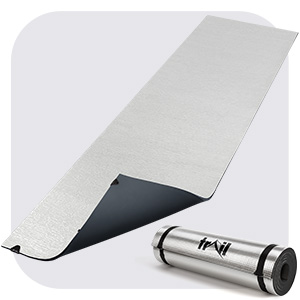How to Create a Camping Sleeping System
How to Create a Camping Sleeping System
Camping is a wonderful way to connect with nature, but it’s only enjoyable if you get a good night’s sleep. To achieve this, it’s important to create a warm and comfortable night-time set up. Especially during the winter when temperatures plummet! Thankfully, we’re here to help. In the following blog, you’ll find all the information you need to create a perfect camping sleeping system. So, you can enjoy a sound night's sleep and wake up feeling fresh and ready for a new day of adventure.

What is a Sleep System?
A sleeping system is the collective name for all the sleeping equipment you need when camping. Namely, a sleeping bag, sleeping mat, sleeping bag liner, and pillow. When combined together, this equipment provides the warmth, comfort, and support you need to enjoy the best sleep possible.
Sleeping Bags

By cocooning you in warmth and comfort, a sleeping bag is the core of a great sleeping system. Put simply, it's the insulation component a sleeping system, keeping the cold air out and your body heat in.
When choosing a sleeping bag, the main thing to consider is its temperature rating. For best results, choose a sleeping bag with a temperature rating suitable for the lowest temperature you'll encounter while camping. For example, if you're camping during the winter, we'd recommend our Alpine 400 Hooded Sleeping Bag, Cotton Flannel Sleeping Bag, or Cotton Flannel Double Sleeping Bag. All three are designed to keep you warm and cosy in temperatures up to -5˚C.
Check out our Sleeping Bag Buying Guide for extra information on choosing a sleeping bag. Or read our Sleeping Bag Comparison Guide for a simple breakdown of the different sleeping bags we sell.
Sleeping Mats

Sleeping mats have been a staple of sleeping systems long before the concept even existed. By creating a stable, cushioned surface, they can have a huge impact on the quality of your sleep. In addition, they help to keep you insulated from the cold, hard ground to keep you extra warm and snug while sleeping.
At Trail, we stock a wide range of sleeping mats, including self-inflating mats, foam roll mats, and ultra-light mats. Each has its pros and cons, so choosing one depends on the type of trip you're going on and your individual requirements. For example, self-inflating mats are comfortable and pack into a compact size, but they're quite heavy to carry. So, if you're hiking, a foam mat or ultra-light mat might be a better option because they're lighter to carry.
For help choosing the perfect sleeping mat, check out our Sleeping Mat Buying Guide. As well as advice on how to choose a mat, it features a comprehensive breakdown of every mat we sell.
Sleeping Bag Liners

Looking to add an extra layer of insulation to your sleeping system? Simply pop a sleeping bag liner inside your sleeping bag to increase the warmth provided. Made from soft breathable polycotton, it's also a great way to take comfort to a whole new level.
Another advantage of a liner is that it protects the inside of your sleeping bag from damp, dirt, and damage. So, it saves you having to regularly clean your sleeping bag. Because the liner is machine washable, you can easily wash it at home to keep it clean and fresh.
At Trail, we stock liners for all our single sleeping bags, including our envelope and mummy sleeping bags. In addition, we have a super-snug fleece liner for our envelope and Alpine sleeping bags. Perfect for keeping you warm during the cold winter months!
Camping Pillows

Inflatable pillows are a perfect way to complete your home-from-home sleeping system. Not only are they ergonomically designed for comfort, but they provide exceptional support. So, no more waking up with neck pain after using clothing as a pillow.
Because they're inflatable, they also pack into a super compact size, making them easier to carry than a normal pillow. Simply pop them in the pocket of your backpack and away you go. Plus, they're fast and easy to inflate. All it takes is three to five breaths!
As well as a single pillow, we also stock a double pillow pack. Perfect if you're going on a family trip or camping as a couple.
Invest in a Quality Tent

In addition to a sleeping system, it’s important to invest in a high-quality tent. For best results, choose a tent with good ventilation to reduce condensation and create a more comfortable sleeping environment.
Although it’s best to avoid camping in the rain, it isn’t always an option, especially in the UK. So, make sure you choose a tent with a good Hydrostatic Head (HH), an indication of how waterproof it is. Usually, a tent with a 3000mm HH will provide enough rain protection. However, if you're camping during the autumn and winter, choose a tent with a 5000mm HH for the best rain protection.
Finally, consider the size of the tent you’re choosing. Ideally, you'll want a tent that comfortably accommodates your sleeping system. Also, you’ll want it to have plenty of space for you and all of your equipment.
Layering for Comfort
As well as wrapping yourself up in a sleeping bag, it’s a good idea to dress in layers. Regulate your body temperature by wearing extra layers during the winter and fewer layers during the summer. Also, remember to pack a beanie and socks to keep your extremities warm and avoid losing body heat.
Pitching Your Tent
Don’t forget to factor in where you pitch your tent. Sleeping on flat ground is important for a comfortable sleep, so choose a space without any slopes. You should also avoid pitching your tent near water as it can result in higher humidity and colder temperatures. Plus, it’s a breeding ground for pesky midges!
Additional Tips
If you have enough room, remember to pack some emergency blankets. You’ll thank us if there’s a sudden drop in temperature. Another top tip is to practise setting up your tent and sleeping system at home. This will prepare you for the real thing and have you pitching like a pro when you hit the campsite.
Conclusion
By choosing the right sleeping equipment and incorporating additional comfort factors, you can easily create the perfect sleeping system. Experiment with your setup and make adjustments based on personal preference and the unique conditions of each camping trip. By doing so, you'll ensure you stay warm and comfortable while sleeping and enjoy the best trip possible.
Don’t let the colder seasons deter you from your adventures!
Must Haves for Winter Camping








